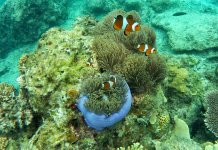This horseshoe crab (Limulus polyphemus) was formerly a crustacean and is the sole survivor of an extinct group of arthropods intermediate between trilobites and arachnids.
The marine animal crab belongs to the family Limulidae and is the only member of the Xiphosura species. These creatures are not crustaceans or crabs at all; they are chelicerates, closely related to arachnids like spiders, ticks, and scorpions. Horefoot crab is also known as horse-shore crab or king crab.
It belongs to the order Xiphosura, class Merostomata, and phylum Palaopoda. According to some English authors, it is an arachnid allied to the scorpion. This difference of opinion regarding its affinities is due to the generalized structure of the animal and to the fact that its nearest allies are extinct.
The horsefoot crab’s body is sometimes two feet long and consists of a head and a hind body, or abdomen. The latter ends in a long spine (telson), extended by the creature in defense. The head is covered with a broad carapace and shapes somewhat like a horse’s hoof. In burrowing, it acts as a shovel, being bent down at nearly right angles to the hind-hody.
There are a compound of simple eyes; the mouth is on the underside, nearly surrounded by six pairs of walking legs, while on the hind body are six pairs of broad swimming legs. There are no antennae, jaws, maxilla, or foot jaws, as in the lobster.
The horsefoot crab breathes using gills attached to the underside of the last five pairs of abdominal legs. These gills consist of a pile of about 100 thin, broad sacs growing out, one pile on each side, from the base of the legs.
Limulus polyphemus inhabits North America, from Boothbay, Maine, to the West Indies and Honduras. It is most abundant in shallow, reclaimed, sandy, or muddy bays in New Jersey, Virginia, and North Carolina. Several other species inhabit the seas of the Eastern Archipelago, China, the Philippines, and southern Japan. In the United States, it is used as fertilizer, while in Malaya, it is sold as food.
The Limuli date from the Devonian. An allied group in shape and structure approaching scorpions is the Eurypterida. One of which (Stylonurus laccoanus) of the Devonian of New York and Pennsylvanian was about five feet in length, while the British Pterygotus anglicus is estimated to have been about six feet in length and two feet across. It is now thought that scorpions descended from merostomes, which became adapted for terrestrial life.
Read More: Halitrephes maasi Jellyfish Facts







